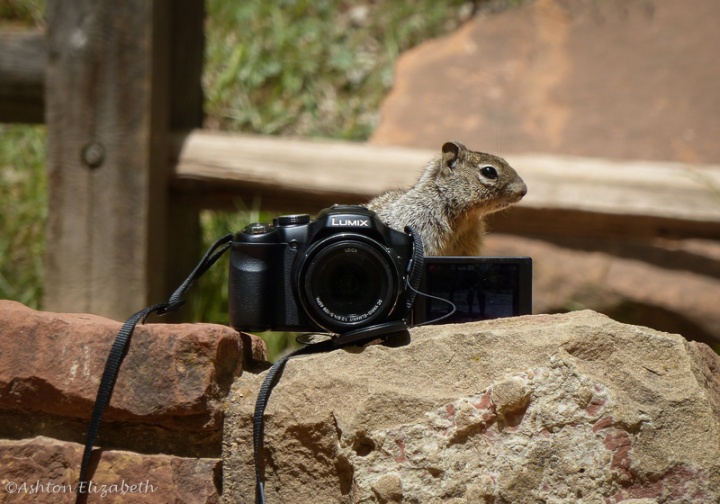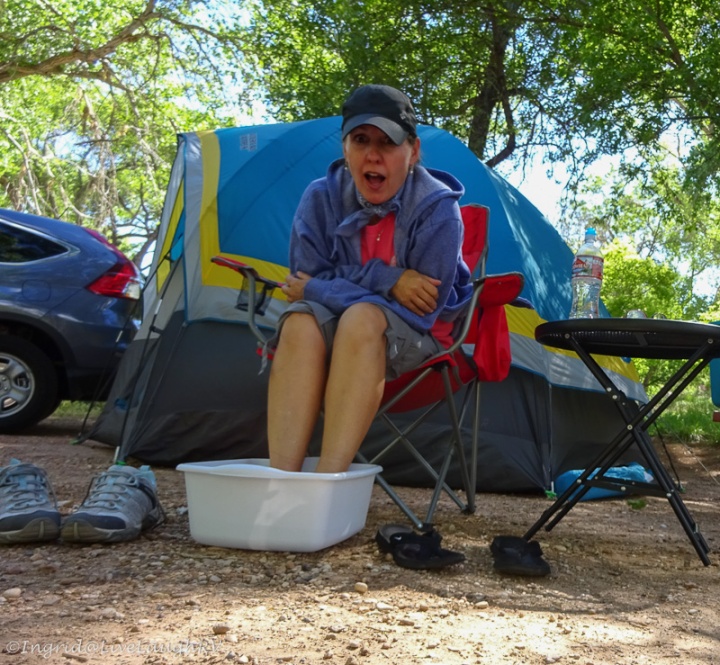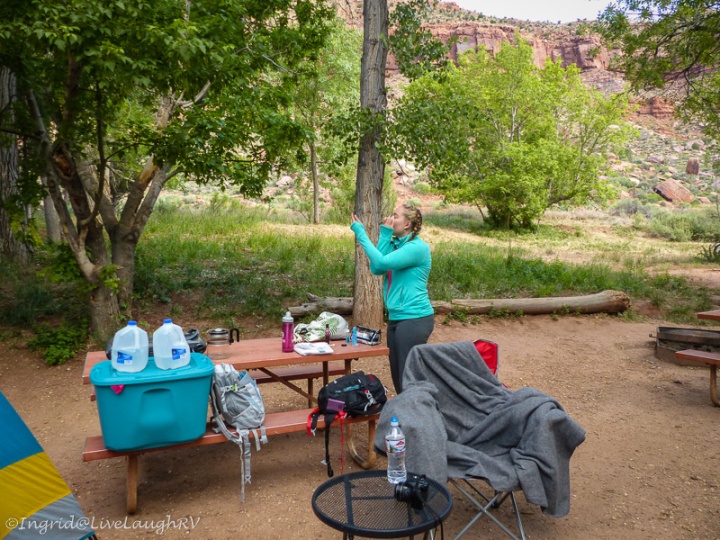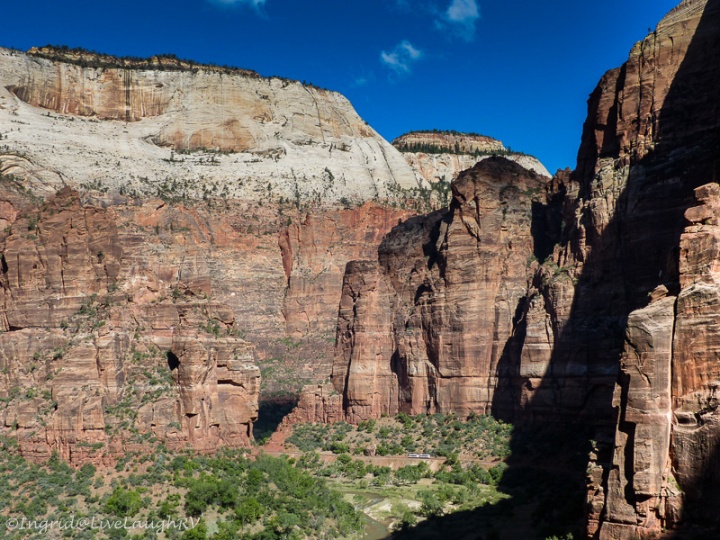With our mother/daughter trip already a month in arrears, Ashton and I still haven’t stopped talking about our exciting adventure. Looking back, I wonder what made this trip such a fun adventure and total success. No doubt, I attribute it to good planning and organization which ultimately lead to a wonderful camping trip experience.
Our Utah excursion was one of the best trips my daughter and I have ever shared and that’s saying a lot. Let’s face it, it’s no easy feat beating a trip to Disney World. Our Disney vacation and a trip we took to South Dakota a few years ago still rank pretty high on our list of epic excursions, but this trip to Zion National Park may have topped those two previous vacations.
When Ashton and I decided we were long overdue for a gals get away, our scheming began in earnst weeks in advance. So what exactly did we do that helped make our camping trip so successful?
This post contains affiliate links. However, I only share items we use and believe in.
OUR TOP 9 TIPS FOR PLANNING A GREAT CAMPING TRIP…..
1. Location & Budget: Where to go on vacation? Ashton and I pulled out the atlas and began searching within a large radius around her home in Phoenix, Arizona. First and foremost, we discussed budget. Our budget was the main reason we decided to drive versus fly and camp versus hotel.
The length of our trip would be five days and four nights. We looked for a scenic location that we could drive to in one day but could also break up the drive if there was a scenic place to stop along the way. Zion National Park fit the criteria for our excursion perfectly.
Once we decided on a national park as the destination, we knew we wanted to tent camp. In my opinion, camping is a much more intimate experience with the environment than staying in a hotel. Camping puts us up close and personal with our surroundings and wildlife. Trust me, I’m not saying there isn’t a time and place for the comforts of a hotel room, I just feel closer to nature when I camp, especially in a national park, but I do like mixing it up depending on where my travels take me. Ah, this is why an RV is the best of both worlds 😎 I do love my RV!
Since taking the RV for this particular trip to Zion National Park wasn’t an option, tent camping was the best choice for these two gals and at $20 a night, we easily stayed within our budget. We knew driving and camping would be the biggest bang for our buck.
2. Create check lists. Our first list included the items needed for camping which obviously encompasses the tent, air mattresses, bedding, flashlights, ax/knives, lighter/matches.
We started a second list of equipment needed for cooking which included the Coleman Stove(s), cookware, plates, utensils, cleaning supplies, towels.
Our third list was for our personal toiletries and clothing. When you’re camping, you need to think about where you’ll be cleaning up and showering. A beach bag and flip flops have served me well over the years in keeping me organized while using a public facility. However, when a campground offers no place to shower, like the South Campground at Zion National Park, there’s nothing better than a package of baby wipes to keep you feeling fresh especially after a long arduous hike. Who knew baby wipes had multiple uses?

When it came to clothing, we focused on bringing items we could layer and made sure we brought rain gear and cold weather gear. Hiking shoes with good traction were also a must. Be sure you have a realistic grasp and understanding of the type of climate and landscape of your location and pack accordingly.
3. Food planning and preparation. Ashton and I decided we didn’t want to eat out much. Plus, we’d be traveling through some remote countryside while passing by the occasional small town. It was important to us that we be totally self-sufficient, eat healthy, and not rely on trying to find a place to grab something to eat.
 We made a meal plan (another list) and then divided up the grocery list and cooking preparation.
We made a meal plan (another list) and then divided up the grocery list and cooking preparation.
We cooked meals at home weeks in advance (like spaghetti and chili) and then froze these meals. During our trip when it was time to eat, we simply needed to reheat the food at our campsite.
We also pattied out burgers, marinated chicken breasts, then seasoned and individually saran wrapped everything and froze. The morning of travel, we took all the frozen items and placed them in our cooler topped with a bag of ice. Which ever item thawed first, dictated the order in which we ate the meals.
I could do a whole separate post on our meals and snacks. We really did well in our planning and prep. We never felt hungry, we ate healthy, and stayed within our budget.
4. Plan for travel. I’m a huge believer in physical maps. We’ve all heard the horror stories of a GPS leading folks astray. There’s nothing wrong with using a GPS, but in remote country, it’s always wise to confirm the route with a physical map so you don’t find yourself on a one lane gravel, rutted road in the middle of no where. It happens!
You can’t possibly do too much research or have too much information. Always stay updated on weather and road conditions.
Are there forest fires anywhere near your destination or along your route? How about road closures, landslides, construction? If you have a reservation, call and confirm ahead of time. If you don’t have a reservation what are your chances of finding a campsite or lodging? What are your backup options?
Have a plan A, B and C. When it comes to travel, flexibility is key and things DO go wrong. Never did we think we were going to get snowed on during that first night at the Coral Pink Sand Dunes. Thank goodness we packed extra blankets. It sure got cold! There was never a mention in the weather report or on radar about the severity of the storm we experienced. I did my homework and things still went askew. But it added to the adventure, thus no complaints.
5. Don’t procrastinate and wait until the last minute to throw things together. Planning ahead of time is crucial. Off in the corner of daughters garage, we started gathering a small pile of camping gear weeks in advance. We spent time checking and rechecking the equipment. We practiced pitching the tent in the backyard, which made us look like pros at the campground. Yes, we impressed 😎
We also made sure all the gear was clean and in good working condition with no missing parts. And in the case of tent stakes and propane bottles, we made sure we had extras.

6. Organization – load up. I like using water-tight rubber bins to keep us organized. As long as we’re not in bear country, we can keep the bin with kitchen supplies (pans/plates/utensils/matches) handy on the picnic table. It’ll keep squirrels, mice, and water out. We used another bin for our dry foods but did keep that one in the car at all times.
We used different sized bins determined by the amount of supplies and separated by subject. BUT before filling the bins, we made sure they, along with the cooler, fit into the back of the Honda CRV.
By having everything organized in one spot in the garage, on the day of travel, it was convenient to load up and hopefully not forget anything. This made life easy for Ashton considering she was loading the car by herself. I was located an hour away.
7. Review essentials – medications and camera gear. A day or two before travel day, make sure you pack medications, check your first aide kit, review your camera gear making sure batteries are charged and you have extra media cards, have emergency contacts written on paper in case cell phones die or won’t work, pack last minute things.
I love this power inverter. We were able to keep things charged. We couldn’t find any outlets at the campground not even in the restroom. Thus, this inverter saved us by keeping our phones and cameras charged.
8. Communicate with loved ones regularly. In this day of technology, it’s easier than ever to stay connected. Keep your loved ones back home up to date on your where abouts. That way, should something unfortunate occur, your loved ones will have a general idea of your last location. This is also the perfect excuse to take selfies and share, but please don’t overdo and annoy your friends and family stuck back home working.

I usually texted my husband once in the morning letting him know our general itinerary and again later in the day when we returned to camp. My daughter would do the occasional post to Facebook or Instagram. When we overnighted at the Coral Pink Sand Dunes, we had no cell service but the ranger was kind enough to allow us to use the land line so I could call hubby and let him know where we were spending the night. Thus, we didn’t  disappear for five days leaving loved ones back home worried.
disappear for five days leaving loved ones back home worried.
9. Be flexible. Things happen and may not go according to plan. The weather may not agree on the day you have that epic hike planned. Don’t force the plan, adjust. Maybe a rainstorm is the perfect excuse to visit local stores, or a coffee shop, or brewery. Or spend a little extra time at the visitor center learning about the area. How about a museum?
Remember safety and prevailing on the side of caution should always be paramount. Changing plans at the last minute on a whim or due to unforeseen circumstances, has provided some of my most memorable experiences.
So let’s review my top nine tips on how to plan for a great camping trip ….
- choose a location and budget

- create check lists
- plan meals and do food prep ahead of time
- plan the travel and do research
- don’t procrastinate and wait until the last minute
- organization is key
- review essentials and continue to review your check lists
- communicate regularly with loved ones back home
- be flexible and have a good time
And how’d we do on that budget? Awesome! First, let’s not take into consideration our groceries. Whether on vacation or at home, we still have to eat. So that cost is an everyday expenditure and not associated exclusively with the trip, but I will included the two meals that we did eat out and the stop at the coffee shop at the Zion Lodge. I’m also not including my $80 seasonal national park pass which I had purchased at the Grand Canyon a month earlier.
Five days and four nights cost us just shy of $200 which covered our campsite fees, gasoline, and eating out (2 meals). Ashton and I split the cost making our five day camping trip a whopping $100 per person for the entire trip. Quite the deal, wouldn’t you agree?
So are you ready to get out your camping gear and visit the nearest national park? I know I am and can’t wait to go again!
This post contains affiliate links, which means under certain circumstances I might receive a small amount of compensation for linking a product. I’ve shared products we use and love. By sharing, it is my hope you find the links helpful, creating a win for both of us. LiveLaughRV is a participant in the Amazon Services LLC Associates Program, an affiliate advertising program designed to provide a means for sites to earn advertising fees by advertising and linking to amazon.com. Thank you for your support!






